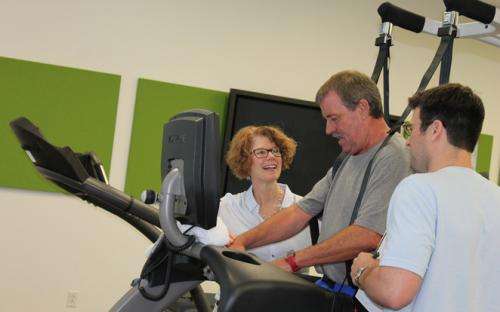Research project puts stroke patients back on their feet

Finding the will to exercise routinely can be challenging enough for most people, but a stroke presents even more obstacles. Yet aerobic exercise may be crucial for recovery and reducing the risk of another stroke or even death.
Pam Bosch, associate professor of physical therapy at Northern Arizona University, is researching the role of aerobic exercise in patients recovering from stroke, and her approach may open the way for patients to experience faster recovery and a higher quality of life.
A few facts about stroke show the importance of Bosch's pilot study. Stroke is the leading cause of long-term disability in the United States, affecting more than 800,000 people a year, and more than one third of that number are under 65. Many of the survivors were not physically fit to begin with, so among their new challenges are mobility and participation in everyday activities while likely facing some degree of paralysis on one side of their body.
Typically, there is an urgency to focus on overcoming those impairments through physical therapy skills training. But Bosch thinks something is missing: fitness as a foundation for recovery.
"My hypothesis is that basing the exercise prescription on a measure called ventilatory threshold and using an interval training protocol during treadmill walking may be an important component of rehabilitation," Bosch said.
Ventilatory threshold—a familiar concept to runners who use interval training—is a value that can be used to establish an aerobic exercise prescription. Bosch measures a patient's oxygen levels during exercise to determine when effort becomes labored.
"Using that baseline for the prescription should push the patients a little harder," Bosch said. "From what I've seen so far, they are able to meet the challenge."
Bosch said she prefers treadmill walking for aerobic training because walking is something people do every day and it generates other benefits, such as cardiovascular health and the stimulation of neuroplastic changes that come when people practice a skill.
Bosch is screening patients from the Phoenix area while working with a collaborator in South Carolina. "Our hope is to keep testing people as we seek funding," Bosch said. "We want enough data to support the hypothesis so we can conduct a larger-scale trial."




















